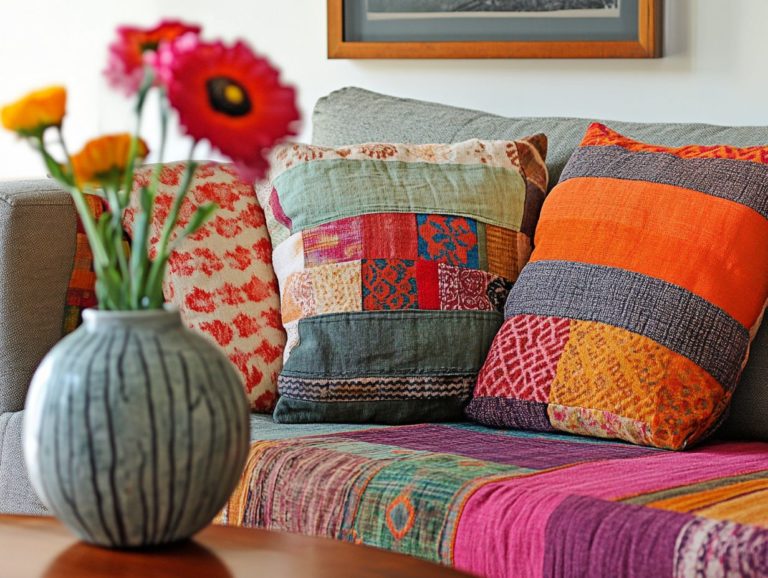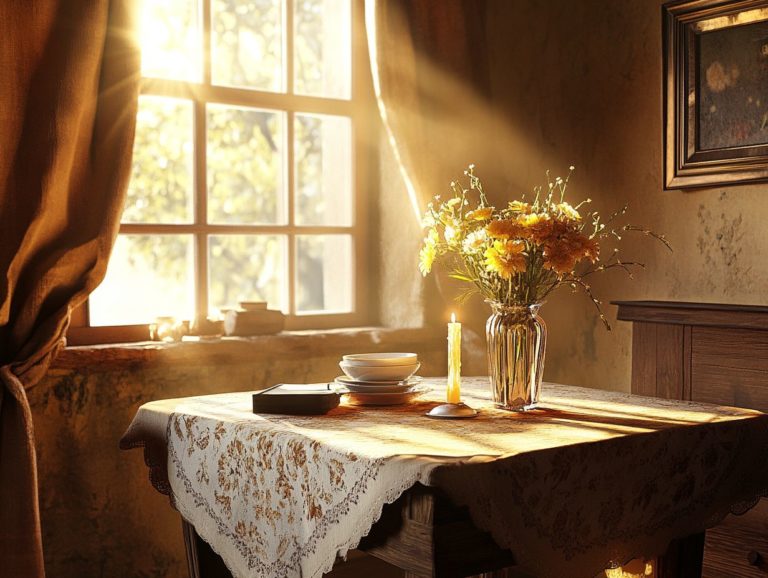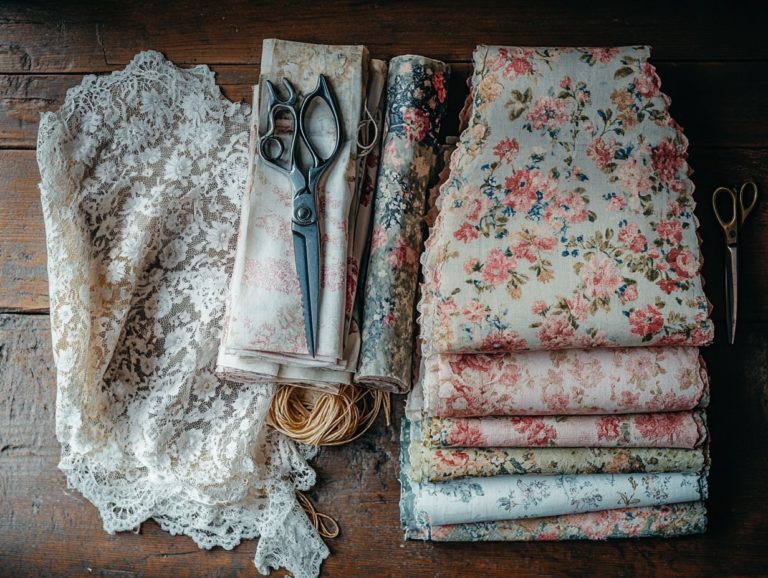Embroidered Vintage Fabrics: A Timeless Choice
Embroidered vintage fabrics present a captivating blend of history and artistry, poised to elevate any space you wish to enhance. With rich origins and diverse techniques behind their creation, these fabrics weave tales of craftsmanship and culture that speak to the soul.
This article delves into the many benefits of incorporating such textiles into your home decor. It also offers essential care tips to ensure their longevity and beauty.
You’ll also discover creative ideas for utilizing these unique pieces, along with insights on where to find high-quality options. Picture how they can transform your living environment into something truly extraordinary.
Contents
- Key Takeaways:
- History of Embroidered Vintage Fabrics
- Types of Embroidery Techniques
- Overview of Different Styles
- Advantages of Using Embroidered Vintage Fabrics
- Durability and Unique Aesthetic
- How to Care for Embroidered Vintage Fabrics
- Cleaning and Maintenance Tips
- Incorporating Embroidered Vintage Fabrics into Your Home Decor
- Where to Find and Purchase Quality Embroidered Vintage Fabrics
- Frequently Asked Questions
- What makes embroidered vintage fabrics a timeless choice?
- Are there any benefits to using embroidered vintage fabrics?
- How can I incorporate embroidered vintage fabrics into my home decor?
- Can I wear embroidered vintage fabrics in modern styles?
- How do I care for embroidered vintage fabrics?
- Where can I find embroidered vintage fabrics?
Key Takeaways:
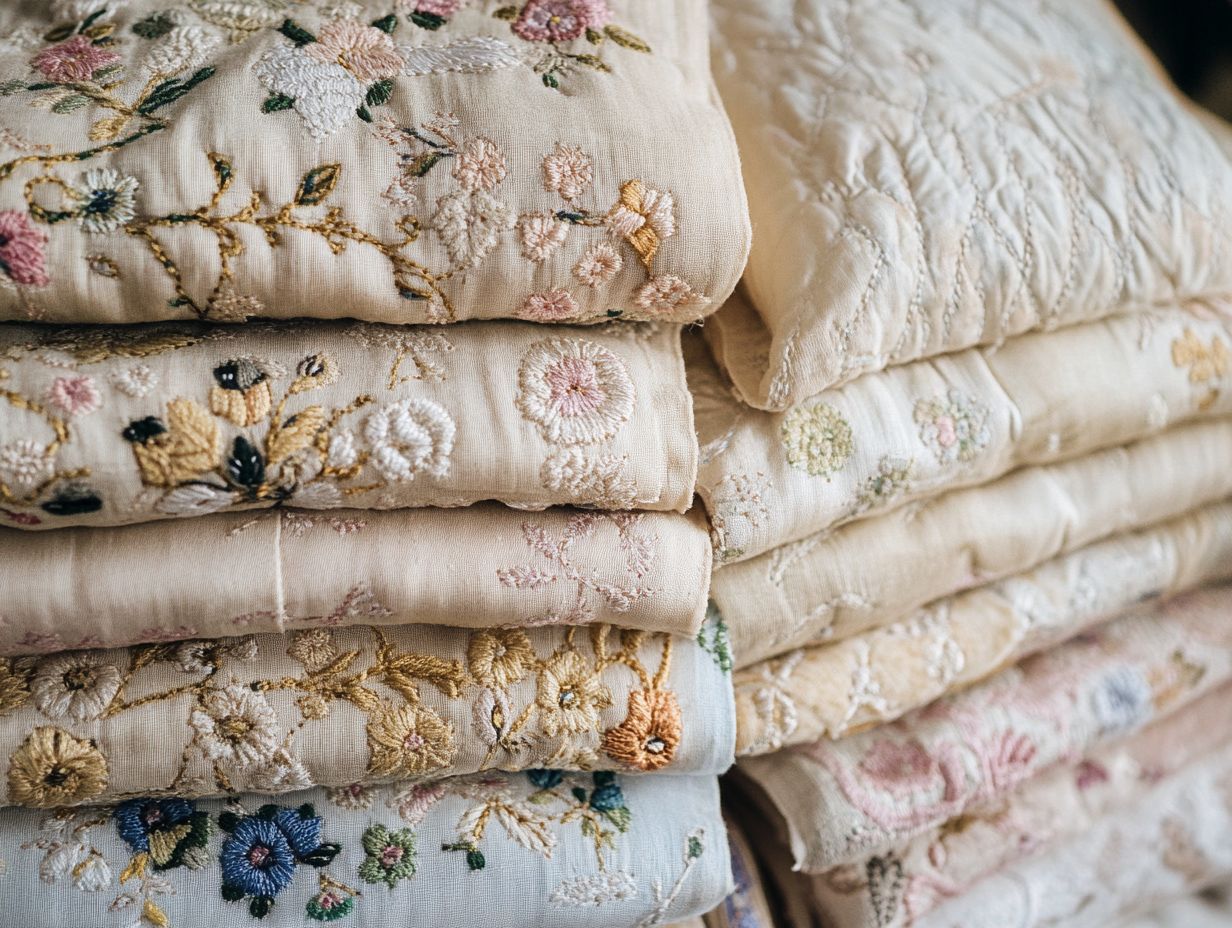
- Add a timeless charm and unique aesthetic to any space, bringing a touch of history and elegance.
- Enjoy beautiful yet durable fabrics, making them a practical choice for both decorative and functional purposes.
- Get creative when incorporating these textiles into your home decor. Have fun with different styles and techniques to add a personal touch to your space.
History of Embroidered Vintage Fabrics
The history of embroidered vintage fabrics unfolds like a rich tapestry. It is intricately woven with the threads of various cultures and eras. Picture the artistry of ancient Egypt, where lotus flowers and floral patterns first blossomed. Fast-forward to the elegant creations flourishing in Italy and France during the Renaissance.
As you trace this evolution, you’ll encounter the British manufacturing boom of the 19th century. This led to the vibrant floral designs that captivated the 20th century. This captivating journey showcases changing aesthetic preferences and highlights the cultural significance of embroidered textiles across different societies, including influences from the Silk Road and Middle East.
Origins and Evolution
The origins of floral fabric can be traced back to ancient Egypt, where motifs like the lotus flower symbolized purity and rebirth. Over centuries, these designs evolved through influences from the Silk Road, adapting to various regional styles.
This rich history ultimately led to the exquisite embroidered vintage fabrics you admire today. As cultures intertwine and flourish, floral patterns reflect not only aesthetic beauty but also profound cultural narratives.
In India, intricate paisley designs emerged, conveying concepts of fertility and prosperity. Meanwhile, vibrant Japanese kimono fabrics often feature cherry blossom motifs, celebrating the fleeting nature of life.
Materials have played a crucial role in this journey. Silk, cotton, and linen were meticulously chosen to enhance the visual and tactile experience. This thoughtful selection allowed these fabrics to resonate with both domestic and global audiences throughout history.
Types of Embroidery Techniques
Delving into the diverse array of embroidery techniques reveals an exquisite realm of artistic expression. You will encounter everything from traditional methods that elegantly employ gold thread and Italian velvet to modern innovations that weave in floral patterns and cotton chintz.
Each technique narrates its own distinctive story, reflecting the rich tapestry of cultures and history.
Overview of Different Styles
Embroidered vintage fabrics offer a rich tapestry of options. Featuring vibrant floral designs, they adorn kimonos and soft furnishings. These designs come alive with watercolour effects, adding depth and personality to each piece.
The unique characteristics of these fabrics stem from various cultural practices, each imbuing the textile design with its own story. For example, the intricate motifs of Indian embroidery are deeply rooted in symbolism. Japanese techniques exemplify elegant minimalism, often highlighting the beauty of nature, a theme echoed in the revival of vintage fabrics in contemporary decor.
Today, floral aesthetics are making a comeback in contemporary fashion and home decor. They evoke nostalgia and artistry. Whether it’s delicate cushion covers blossoming with flowers or flowing dresses inspired by garden blooms, these fabrics infuse warmth and character into modern spaces and wardrobes. For those interested in enhancing their decor, exploring the allure of vintage silk fabrics can add a unique touch.
Advantages of Using Embroidered Vintage Fabrics
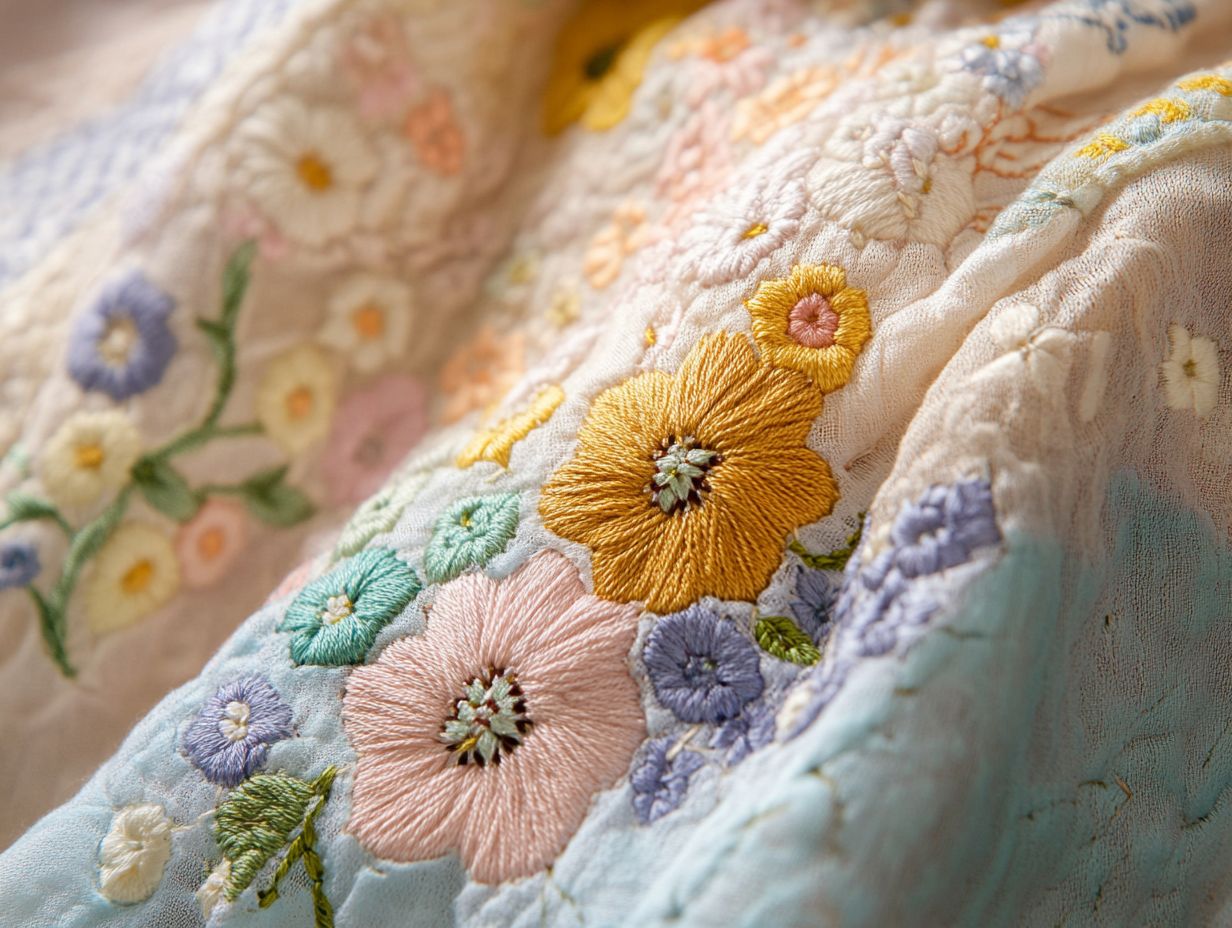
Embroidered vintage fabrics present a distinctive aesthetic and remarkable durability that elevate both fashion and home d cor. These floral options embody the essence of flower power and timeless beauty, allowing you to infuse your personal style with a touch of elegance and charm.
Durability and Unique Aesthetic
The durability of floral fabric in embroidered vintage pieces offers longevity and a unique aesthetic. It elevates soft furnishings, infusing your design scheme with cultural significance.
Crafted from high-quality threads and strong weaving methods, these fabrics withstand daily use without fading or fraying. The intricate patterns and vibrant colors provide visual appeal while reflecting the beauty of handwoven vintage fabrics lovingly passed down through generations.
In contemporary spaces, these floral fabrics become statement pieces. They ground your rooms with rich textures and eye-catching designs. Homeowners are increasingly captivated by their timeless charm, appreciating how vintage dress fabrics harmonize with various decorative styles while maintaining an enduring presence.
How to Care for Embroidered Vintage Fabrics
Taking care of your embroidered vintage fabrics is important for keeping them beautiful. By following proper cleaning and maintenance techniques, you can preserve the stunning floral choices and intricate flower patterns that characterize these exquisite pieces.
Cleaning and Maintenance Tips
Using appropriate cleaning techniques for your embroidered vintage fabrics is essential. Gentle methods will help preserve those intricate floral patterns while protecting the delicate fibers.
To maintain the beauty of these treasured pieces, hand wash them in lukewarm water with a mild detergent. Avoid harsh chemicals that can dull colors and degrade the fabric.
After washing, air dry the fabrics flat. This prevents stretching and helps maintain their original shape. Storing your embroidered items in a dark, cool place far from direct sunlight will keep those vibrant floral patterns looking fresh.
Regularly check for signs of wear and gently dust the surface. This can significantly extend their life, allowing the elegance of the embroidery to shine for years to come.
Incorporating Embroidered Vintage Fabrics into Your Home Decor
Incorporating embroidered vintage fabrics into your home d cor invites a realm of creative possibilities. Floral designs can elevate the atmosphere of any space, enriching the environment and showcasing a unique aesthetic that beautifully reflects your personal style.
Creative Ideas and Inspiration
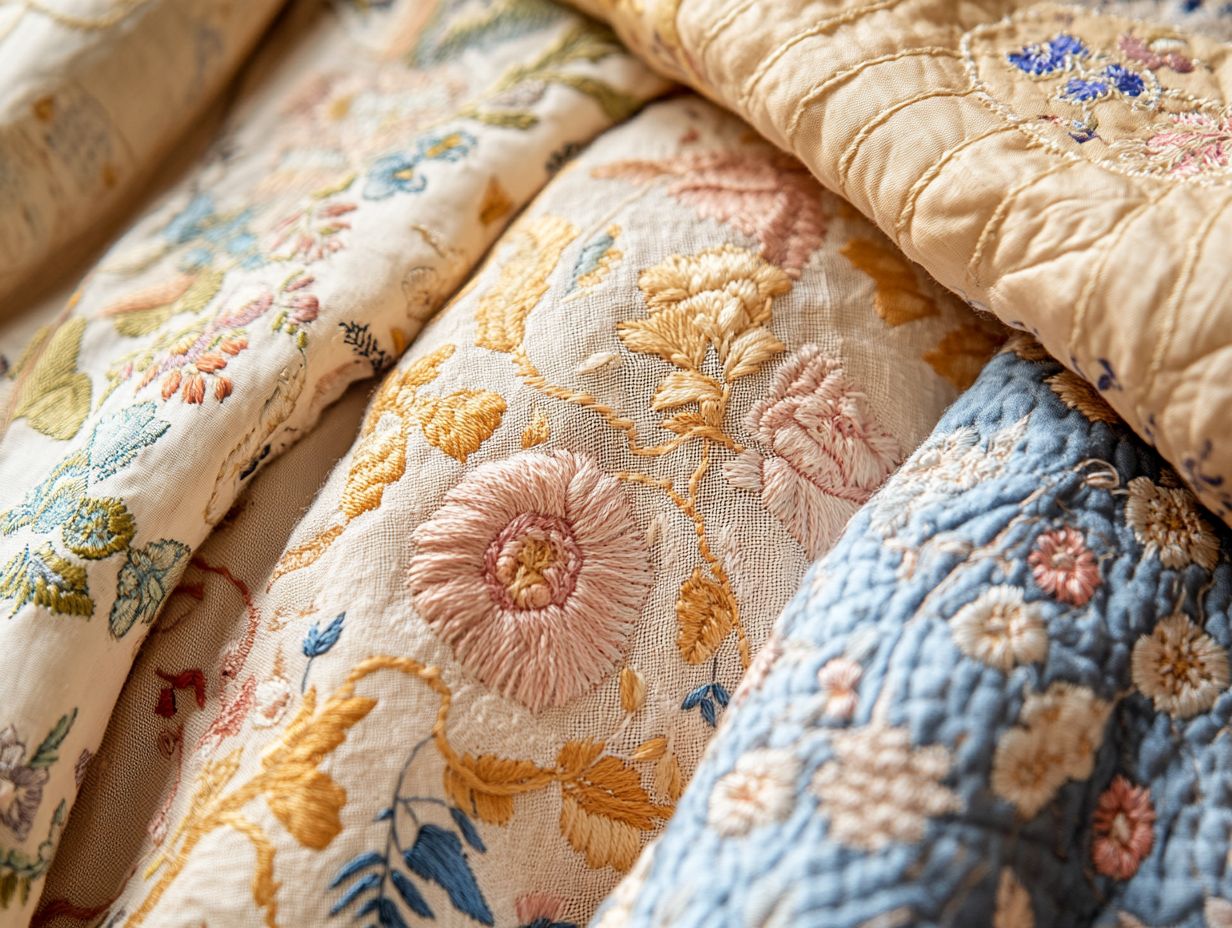
Creative ideas for incorporating floral fabric into your home d cor can truly transform your spaces. Soft furnishings featuring unique flower patterns evoke vintage charm and timeless elegance, reminiscent of the 18th century.
These designs can instantly brighten up any room! Imagine draping a floral fabric throw blanket over a solid-colored sofa; it adds the perfect pop of color and texture. In your dining room, a floral tablecloth can set a charming atmosphere for both casual meals and sophisticated gatherings.
Using floral fabrics for cushion covers in bedrooms enhances the serene ambiance, creating a restful retreat. In children’s playrooms, whimsical floral patterns can spark creativity and joy, showcasing the versatility of these delightful designs.
Where to Find and Purchase Quality Embroidered Vintage Fabrics
Discovering and acquiring high-quality embroidered vintage fabrics can be immensely gratifying, especially when you know where to search. Explore online marketplaces, seek out specialty shops, or visit local boutiques to uncover exquisite floral fabric options.
Tips for Sourcing and Shopping
When on the hunt for quality embroidered fabrics, a few key tips can elevate your sourcing experience. Start by exploring different floral options and identifying reliable online shopping platforms and vintage markets.
Evaluate the condition of the fabrics. Look for signs of wear, vibrant colors, and the integrity of the stitching. Diligently research sellers, whether at flea markets or online boutiques. Read reviews and check return policies as they indicate a seller’s commitment to customer satisfaction.
Compare prices across platforms to find fair market value. Don’t overlook local craft fairs; they often reveal unique finds at more appealing prices. Engage with sellers about the history and sourcing of their embroidered pieces to ensure authenticity and quality. For those interested in unique designs, explore the timeless appeal of vintage textiles.
Frequently Asked Questions
What makes embroidered vintage fabrics a timeless choice?
Embroidered vintage fabrics have a timeless appeal due to their intricate designs and high-quality materials. They carry a sense of history and nostalgia, making them popular for those seeking unique pieces. 16th century and historic patterns are particularly sought after.
Are there any benefits to using embroidered vintage fabrics?
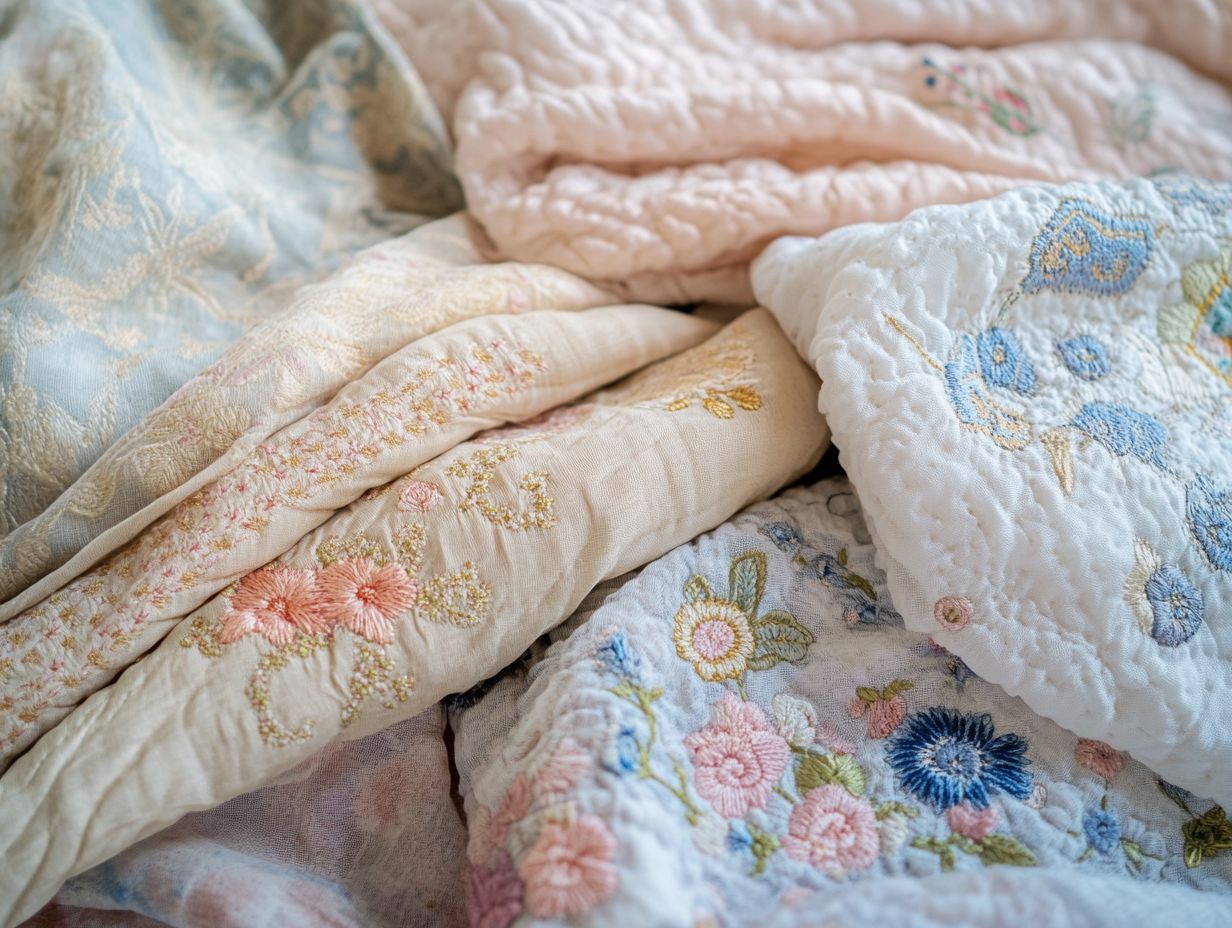
Yes, several benefits come with using embroidered vintage fabrics. They are often made from natural materials like cotton, linen, or silk, making them more environmentally friendly than synthetic fabrics. They are also durable and can withstand everyday wear and tear.
How can I incorporate embroidered vintage fabrics into my home decor?
There are many ways to incorporate embroidered vintage fabrics into your home decor. Use them as throw pillows, tablecloths, or even frame them as artwork. They add a touch of elegance and charm to any room.
Can I wear embroidered vintage fabrics in modern styles?
Absolutely! You can wear embroidered vintage fabrics in modern styles. Mix them with contemporary pieces for a unique, eclectic look.
How do I care for embroidered vintage fabrics?
Treat embroidered vintage fabrics with care to keep them beautiful. Hand wash them in cold water and let them air dry.
Where can I find embroidered vintage fabrics?
Discover embroidered vintage fabrics at antique stores, vintage shops, or online marketplaces. Check out local thrift stores too, or ask family and friends for heirloom treasures!

